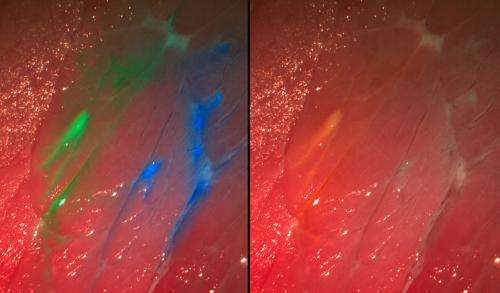Special camera detects tumors

Tumor removal surgeries pose a great challenge even to skillful and experienced surgeons. For one thing, tumor margins are blending into healthy tissue and are difficult to differentiate. For another, distributed domains of cancer and pre-malignancies are difficult to recognize. Up to now, doctors depended exclusively upon their trained eyes when excising pieces of tumors. In the future, a new special camera system can help visualize during operation even the smallest malignant pieces of tumor and thereby support the surgeons during complicated interventions.
The trick: the camera displays fluorescent molecules that "paint" the cancer tissue. These are injected into the patient's blood prior to the operation and selectively attach onto the tumor. If the corresponding area is then illuminated with a specific wavelength, fluorescence is visible and the malignant tissue glows green, blue, red, or any other color, depending on the injected dye, while the healthy tissue appears normal. In this way, the surgeon can see clusters of tumors cells that cannot be recognized by the naked eye.
New system reveals several dyes simultaneously
Researchers at the Fraunhofer Project Group for Automation in Medicine and Biotechnology (PAMB), which belongs to the Fraunhofer Institute for Manufacturing Engineering and Auto- mation (IPA), have developed a new surgical aid, a multispectral fluorescence camera system. In the future, this special camera will integrate into various medical imaging systems such as, surgical microscopes and endoscopes, etc. The scientists from Mann- heim, Germany, will make the debute of a prototype of this high-tech system at the Medica Trade Fair in Düsseldorf in the joint Fraunhofer booth (Halle 10, Booth F05) between 20-23 November. The novel aspect about this camera: it can display several fluorescent dyes and the reflectance image simultaneously in real time – systems available until now have not been able to achieve this. The advantage: arteries and delicate nerves that must not be injured during an intervention can likewise be colored with dye. They, too, can then be detected with the new camera, since they are set apart from their surroundings.
"The visibility of the dye to the camera depends in large part on the selection of the correct set of fluorescence filters. The filter separates the incident excitation wave- lengths from the fluorescing wavelengths so that the diseased tissue is also set apart from its surroundings, even at very low light intensities," says Nikolas Dimitriadis, a scientist at PAMB. The researchers and their colleague require only one camera and one set of filters for their photographs, which can present up to four dyes at the same time. Software developed in-house analyses and processes the images in seconds and presents it continuously on a monitor during surgery. The information from the fluorescent image is superposed on the normal color image. "The operator receives significantly more accurate information. Millimeter-sized tumor remnants or metastases that a surgeon would otherwise possibly overlook are recognizable in detail on the monitor. Patients operated under fluorescent light have improved chances of survival," says Dr. Nikolas Dimitriadis, head of the Biomedical Optics Group at PAMB.
In order to employ the multispectral fluorescence camera system as adaptably as possible, it can be converted to other combinations of dyes. "One preparation that is already available to make tumors visible is 5-amino levulinic acid (5-ALA). Physicians employ this especially for glioblastomas – one of the most frequent malignant brain tumors in adults," explains Dimitriadis. 5-ALA leads to an accumulation of a red dye in the tumor and can likewise be detected with the camera. The multispectral fluorescence imaging system should have passed testing for use with humans as soon as next year. The first clinical tests with patients suffering from glioblastomas are planned for 2014.

















